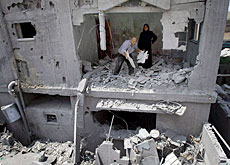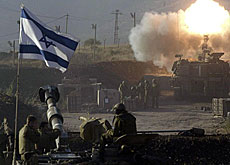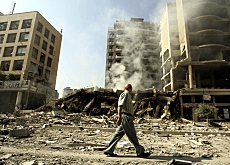Concern raised about crisis in Gaza

United Nations and Swiss agencies are warning of a humanitarian crisis in the Gaza Strip, which has been largely forgotten due to the conflict in Lebanon.
The head of the Swiss Agency for Development and Cooperation (SDC) for Gaza and the West Bank says the population in the occupied territories feels abandoned.
Mario Carera said the situation in the area had deteriorated over the past few weeks. “The food and security situation is catastrophic,” he told the Swiss news agency.
Carera has just returned from a two-day fact-finding tour to the Gaza Strip.
Karin Wenger, a Swiss journalist who lives in the region, says the Palestinians in the Gaza Strip depend on foreign and food distribution.
“The shift from poor to very poor is noticeable,” she told swissinfo about the situation since the start of the Israeli military operation in Gaza at the end of June.
“Israel’s armed forces attack the Strip with up to 300 shells a day using aircraft and warships. Incursions by tanks and bulldozers terrorise the population.
“Among the more than 170 victims killed in this invasion are more than 50 children. This is a clear breach of international humanitarian law under which the civilians should be protected,” she said.
Wenger, who works for several newspapers in Switzerland and Germany, said Israeli tanks and bulldozers had destroyed houses and large parts of agricultural land, as well as power cables and irrigation systems.
“The impact on farmers and on civilians is therefore tremendous.”
Desperation
Both Carera and Wenger say the difficult financial situation of many Palestinians is a result of an international boycott of the militant Islamic Hamas-led government which won elections in the occupied territories earlier this year.
Carera said most shops had closed and public life had come to standstill.
In June Israel destroyed the only power plant in Gaza leaving nearly half the local population without electricity and the main border crossing at Rafah was also closed.
Wenger for her part says the Gaza Strip resembles a huge prison. “It’s an overall feeling of hopelessness and desperation. This leads to more and more violence in the community.”
Deliveries halted
The Swiss government’s aid agency and its partner organisations in the region are facing increasing logistical difficulties.
Some emergency aid supplies could not be delivered to Gaza because they were blocked at the border by the Israelis, according to Carera.
SDC and the Palestinian health authorities had agreed on the delivery of medications as part of a coordinated aid effort in June.
SDC’s partner organisations even had to suspend or cancel a series of other projects including the relaunch of crèches for children, welfare centres and agricultural land.
Carera also said there was a shortage of cement and steel bars used to reinforce masonry structures which prompted a four-fold increase in prices.
swissinfo
In 2005, SDC’s budget for the occupied territories was SFr17.2 million ($14 million). With the foreign ministry’s contribution, this rose to SFr29.1 million. For 2006 the SDC’s projected budget is SFr21.6 million.
Almost 4,000 people have been killed (around 1,000 Israelis and 3,000 Palestinians) since the beginning of the intifada in 2000.
Nearly 50% of the population lives in poverty.
The Gross National Product per inhabitant is $1,307.

In compliance with the JTI standards
More: SWI swissinfo.ch certified by the Journalism Trust Initiative



You can find an overview of ongoing debates with our journalists here . Please join us!
If you want to start a conversation about a topic raised in this article or want to report factual errors, email us at english@swissinfo.ch.